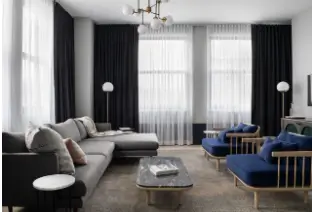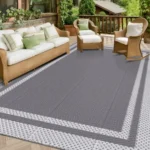Creating a cozy, dark space in your home can be a game-changer, whether you’re trying to sleep in on weekends, enjoy a movie night, or keep your room cool during sunny days. However, one common issue with Blackout curtains Dubai is the pesky light that sneaks in from the top, where they meet the curtain rod. This gap can let in unwanted sunlight, disrupting your ambiance or sleep. Fortunately, there are several simple, effective, and budget-friendly ways to block light from the top of curtains. In this guide, we’ll explore practical solutions to help you achieve a darker, more comfortable space.
Why Does Light Leak From the Top of Curtains?
Before diving into solutions, it’s helpful to understand why light seeps in. Curtains often don’t sit flush against the wall or window frame, especially at the top where the rod is mounted. This creates a small gap that allows light to filter through. Factors like the type of curtain rod, the curtain’s design, or improper installation can make this gap more pronounced. The good news? You can tackle this issue with a few easy fixes, no matter your skill level or budget.
1. Use a Curtain Rod Wrap-Around Bracket
One of the simplest ways to block light from the top of curtains is to use a wrap-around curtain rod or brackets. These rods curve at the ends, bringing the curtains closer to the wall and minimizing gaps on the sides and top. This design ensures the curtain fabric hugs the wall, reducing light leakage significantly.
To install a wrap-around rod, measure your window’s width and choose a rod that extends a few inches beyond the frame on both sides. Mount the brackets according to the manufacturer’s instructions, ensuring they’re level. Hang your curtains as usual, and adjust them to cover the window completely. This method is ideal for renters or anyone looking for a non-permanent solution that doesn’t require much effort.
2. Add a Valance or Cornice Board
A valance or cornice board is a decorative and functional addition that can block light from the top of your curtains. A valance is a short fabric piece that hangs above the curtain, while a cornice board is a solid, often padded structure that covers the top of the window. Both options conceal the gap between the curtain rod and the wall, creating a polished look while keeping light out.
You can purchase a ready-made valance or make one yourself with fabric that matches your curtains. For a cornice board, consider a DIY approach using foam board or wood, covered with fabric or paint to suit your decor. Secure the valance or cornice above the curtain rod, ensuring it extends slightly beyond the rod’s edges to block light effectively.
3. Install a Light-Blocking Curtain Liner
If you love your current curtains but want better light control, a light-blocking liner is a fantastic option. These liners are designed to attach to the back of your existing curtains, adding an extra layer that prevents light from passing through. Some liners are specifically made to extend higher than the curtain itself, covering the gap at the top.
To use a liner, measure your curtains and choose a liner slightly larger to ensure full coverage. Many liners come with clips or hooks for easy attachment, making this a renter-friendly solution. Look for blackout liners made of thick, opaque materials for maximum light-blocking power.
4. Use Magnetic or Adhesive Light-Blocking Strips
For a quick and affordable fix, consider magnetic or adhesive light-blocking strips. These are narrow strips of light-blocking material that you can attach to the top edge of your curtains or the window frame. Magnetic strips work well if your curtain rod or window frame is metal, as they snap into place easily. Adhesive strips are great for non-metal surfaces and can be cut to fit any size.
To apply, clean the surface where the strip will go, then press it firmly into place along the top of the curtain or window frame. Adjust your curtains to overlap the strip slightly, creating a tight seal that keeps light out. This method is perfect for those who want a low-effort solution without altering their curtains or window setup.
5. Sew or Attach a Fabric Flap
If you’re handy with a needle and thread or have access to fabric glue, adding a fabric flap to the top of your curtains can work wonders. This involves attaching a strip of light-blocking fabric (like blackout material) to the top edge of your curtains, extending it upward to cover the gap between the rod and the wall.
Measure the gap, cut a piece of fabric to fit, and sew or glue it to the back of your curtain’s top edge. Make sure the flap is long enough to drape over the rod and touch the wall, creating a barrier against light. This DIY approach is customizable and can blend seamlessly with your existing curtains.
6. Adjust Curtain Rod Placement
Sometimes, the issue is simply the placement of the curtain rod. If the rod is mounted too low or too close to the window, it can create a larger gap at the top. To fix this, try raising the rod higher above the window frame—ideally 4-6 inches above—and extending it wider on both sides. This allows the curtains Abu Dhabi to hang closer to the wall and cover more of the window’s edges.
When repositioning the rod, use a level to ensure it’s straight, and secure it with sturdy brackets. If your curtains are too short after raising the rod, consider adding longer curtains or a fabric panel to extend their length.
Final Thoughts
Blocking light from the top of curtains doesn’t have to be complicated or expensive. Whether you opt for a wrap-around rod, a valance, a blackout liner, adhesive strips, a fabric flap, or a simple rod adjustment, each method can make a big difference in creating a darker, more comfortable space. Choose the solution that best fits your budget, style, and skill level, and enjoy a room that feels just right, day or night.
Experiment with these ideas, and don’t be afraid to combine methods for even better results. With a little creativity and effort, you can say goodbye to those annoying light leaks and hello to a cozier, more private home.
Last modified: September 19, 2025







